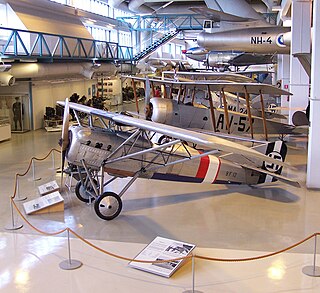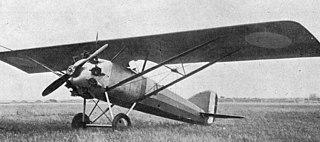| 812 HY | |
|---|---|
 | |
| Role | reconnaissance floatplane |
| Manufacturer | Gourdou-Leseurre |
| Introduction | 23 September 1930 |
| Retired | 1940 |
| Number built | 86 |
The Gourdou-Leseurre GL-812 HY was a 3-seat reconnaissance floatplane, built by Gourdou-Leseurre.
| 812 HY | |
|---|---|
 | |
| Role | reconnaissance floatplane |
| Manufacturer | Gourdou-Leseurre |
| Introduction | 23 September 1930 |
| Retired | 1940 |
| Number built | 86 |
The Gourdou-Leseurre GL-812 HY was a 3-seat reconnaissance floatplane, built by Gourdou-Leseurre.
The prototype, called L-2, was built in 1926-27. It has a steel tube fuselage, and rectangular wooden wing. The tail was two fins, one above and one below the fuselage. The entire plane was fabric covered, except the 283 kW (380 hp) Gnome-Rhône 9A Jupiter engine, which was left uncowled. The prototype was flown to Copenhagen, and demonstrated there to several countries.
Six prototype L-3s were constructed. They had a larger 313 kW (420 hp) Jupiter, steel spars instead of wood, and stronger struts, allowing for shipboard catapult launching. After successfully testing the L-3, the French navy ordered 14 production GL-810 HY aircraft. The first production 810 HY flew on 23 September 1930, taking off from the Seine at Les Mureaux. In 1931, 20 GL-811 HYs were ordered, for operation from the seaplane carrier Commandant Teste and from 1933 to 1934 twenty-nine GL-812 HYs and thirteen GL-813 HYs were ordered.


While most aircraft had been retired by 1939, that August the remaining aircraft were brought together to re-equip the recently re-activated and mobilized Escadrilles 1S2 and 3S3 at Cherbourg and Berre-l'Étang, respectively and perform coastal anti-submarine patrols.
Data from The Encyclopedia of World Aircraft, [5] Aviafrance : Gourdou Leseurre GL-812 HY [3]
General characteristics
Performance
Armament
Related lists

French Naval Aviation is the naval air arm of the French Navy. The long-form official designation is Force maritime de l'aéronautique navale. Born as a fusion of aircraft carrier squadrons and the naval patrol air force, the Aéronavale was created in 1912. The force is under the command of a flag officer officially named Admiral of Naval Aviation (ALAVIA) with his headquarters at Toulon naval base. It has a strength of around 6,800 military and civilian personnel. It operates from four airbases in Metropolitan France and several detachments in foreign countries or French overseas territories. Carrier-borne pilots of the French Navy do their initial training at Salon-de-Provence Air Base after which they undergo their carrier qualification with the US Navy.

Commandant Teste was a large seaplane tender of the French Navy built before World War II. She was designed to be as large as possible without counting against the Washington Treaty limits. During the Spanish Civil War, she protected neutral merchant shipping and played a limited role during World War II as she spent the early part of the war in North African waters or acting as an aviation transport between France and North Africa. She was slightly damaged during the British bombardment of the French Fleet at Mers-el-Kébir in July 1940. Commandant Teste was scuttled at Toulon when the Germans invaded Vichy France in November 1942, but was refloated after the war and considered for conversion to an escort or training carrier. Neither proposal was accepted and she was sold for scrap in 1950.

The Gourdou-Leseurre GL.2 was a French fighter aircraft which made its maiden flight in 1918.

Gourdou-Leseurre was a French aircraft manufacturer whose founders were Charles Edouard Pierre Gourdou and Jean Adolphe Leseurre.

Potez 25 was a French twin-seat, single-engine biplane designed during the 1920s. A multi-purpose fighter-bomber, it was designed as a line aircraft and used in a variety of roles, including fighter and escort missions, tactical bombing and reconnaissance missions. In the late 1920s and early 1930s, Potez 25 was the standard multi-purpose aircraft of over 20 air forces, including French and Polish. It was also popular among private operators, notably mail transport companies.

The Blériot 127 was a French bomber aircraft of the 1920s and 1930s, developed from the Blériot 117 escort fighter. It was a large monoplane of conventional configuration that featured open gunner's positions in its nose and at the rear of its two underwing engine nacelles. The wing airfoil was of sufficient thickness that these latter positions could be accessed from the fuselage in flight.

The Blériot-SPAD S.61 was a French fighter aircraft developed in 1923. Designed by André Herbemont, the S.61 was a conventional biplane, abandoning the swept upper wing used by Herbemont in several previous designs. The prototype S.61 was evaluated by the French Air Force alongside the S.51 as a potential new fighter, but like its stablemate, was rejected. The Polish Air Force was impressed enough to order 250, as well as purchase licences for local production. The Romanian Air Force also ordered 100 aircraft. About 30 were built in Poland, by the CWL.

The CAMS 37 was a flying boat built in France in the mid-1920s that was originally designed for military reconnaissance, but which found use in a wide variety of roles in a large number of versions. It was the first design for Chantiers Aéro-Maritimes de la Seine (CAMS) by the company's new head designer, Maurice Hurel. The prototype was displayed at the 1926 Salon de l'Aéronautique in Paris. The prototype first flew in 1926, and after testing was ordered into service before the end of the year. It was a conventional biplane flying boat very similar to previous CAMS designs, being driven by a pusher propeller whose engine was mounted on struts in the interplane gap. The first production version was the amphibious CAMS 37A that was bought by the French Navy, the Portuguese Navy and the aeroclub of Martinique.

The CAMS 55 was a reconnaissance flying boat built in France in the late 1920s which equipped the French Navy throughout the 1930s.

The Nieuport-Delage NiD.62 was a French sesquiplane fighter from the early 1930s. This machine was a descendant of a long line of Nieuport-Delage fighters that were designed and built during the years immediately after World War I. The NiD.62 was built in 1931 as a fighter for the Armée de l'Air. It served until the late 1930s, when it was replaced by more modern monoplane fighters. By the time of the outbreak of World War II in September 1939, all of the NiD.62s had been withdrawn from front-line fighter escadrilles but were used as trainers in French flight schools. A few aircraft were employed as target tugs. After the French German Armistice and German occupation of North and West part of France in June 1940, the German Luftwaffe had no interest in the NiD.62s and they were scrapped. None survived the war.

The Loire 46 was a French single-seater fighter aircraft of the 1930s. A high-winged monoplane designed and built by Loire Aviation, it was purchased by the French Air Force. It was also supplied to the Spanish Republican forces during the Spanish Civil War, but was almost out of service by the outbreak of World War II.

The Morane-Saulnier MS.230 aircraft was the main elementary trainer for the French Armée de l'Air throughout the 1930s. Almost all French pilots flying for the Armée de l'Air at the outbreak of World War II had had their earliest flight training in this machine. It was the equivalent of the Stearman trainer in the United States air services and the de Havilland Tiger Moth in the British Royal Air Force.

The Gourdou-Leseurre GL-832 HY was a 1930s French light shipboard reconnaissance floatplane designed and built by Gourdou-Leseurre for the French Navy.

The Farman F.300 and F.310 were airliners built in France in the early 1930s. They were high-wing strut braced monoplanes with fixed tailskid undercarriage with a trimotor layout popular with several manufacturers of the time. The cockpit and passenger compartment were fully enclosed. Most saw service in Farman's own airline, whose twelve F.300 variants made up half its fleet in 1931.

The Gourdou-Leseurre GL.30 was a racing aircraft built in France in 1920 which formed the basis for a highly successful family of fighter aircraft based on the same design.

The Lioré et Olivier H-190 was a flying boat airliner produced in France in the late 1920s. Conventional for its day, it was a single-bay biplane with un-staggered wings, its single engine mounted tractor-fashion underneath the upper wing and supported on struts in the interplane gap. Early examples had the pilot's open cockpit located aft of the wing, but this was later relocated forward of the wing.

The Farman NC.470 was a French twin-engined floatplane designed as a crew trainer for the French Navy. It was used in small numbers for both its intended role as a trainer and as a coastal reconnaissance aircraft at the start of World War II.

The Blériot-SPAD S.91 was a French light-weight fighter aircraft. It would be later developed into the Blériot-SPAD S.510, the last biplane produced by the French aeronautic industries.
The Gourdou-Leseurre GL-820 HY family of four-seat single-engined floatplanes were designed and built in France during the latter half of the 1930s by Gourdou-Leseurre. The GL-820 HY and GL-821 HY 02 were shipborne reconnaissance / observation aircraft, while the sole GL-821 HY was built as a torpedo carrier.
{{cite encyclopedia}}: Missing or empty |title= (help)| Wikimedia Commons has media related to Gourdou-Leseurre GL-812 HY . |